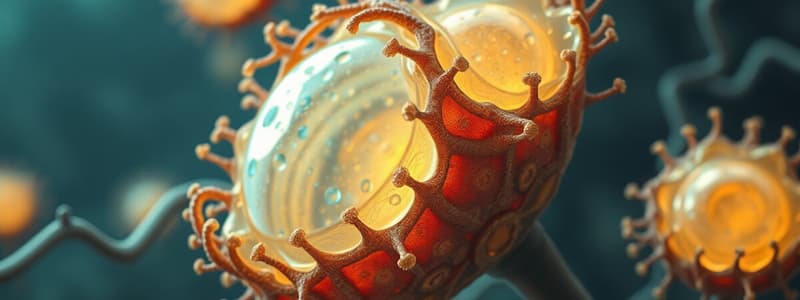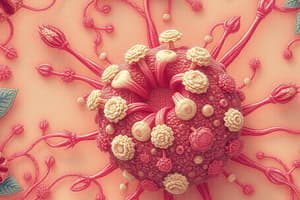Podcast
Questions and Answers
What characteristic distinguishes embryonic stem cells from adult stem cells?
What characteristic distinguishes embryonic stem cells from adult stem cells?
- Embryonic stem cells are found in differentiated tissues.
- Adult stem cells are capable of becoming totipotent.
- Embryonic stem cells can give rise to any cell in the body. (correct)
- Adult stem cells have a virtually limitless self-renewal capacity.
Where are tissue (adult) stem cells primarily found?
Where are tissue (adult) stem cells primarily found?
- In undifferentiated tissues only
- Within differentiated tissues (correct)
- In the inner mass of the blastocyst
- In the blood circulation
Which type of stem cells are characterized by continuously proliferating cells with a short life span?
Which type of stem cells are characterized by continuously proliferating cells with a short life span?
- Embryonic stem cells
- Permanent stem cells
- Stable stem cells
- Labile stem cells (correct)
What defines permanent stem cells?
What defines permanent stem cells?
Which of the following is NOT a source of adult stem cells?
Which of the following is NOT a source of adult stem cells?
What is the main role of the G1/S checkpoint in the cell cycle?
What is the main role of the G1/S checkpoint in the cell cycle?
What type of growth refers to an increase in the number of cells by mitosis?
What type of growth refers to an increase in the number of cells by mitosis?
Which phase of the cell cycle is primarily responsible for DNA synthesis?
Which phase of the cell cycle is primarily responsible for DNA synthesis?
What happens to a cyclin after it has completed its round of phosphorylation?
What happens to a cyclin after it has completed its round of phosphorylation?
Which process involves the specialization of a cell and expression of specific genes?
Which process involves the specialization of a cell and expression of specific genes?
What is the purpose of morphogenesis during embryogenesis?
What is the purpose of morphogenesis during embryogenesis?
Which of the following is NOT a characteristic of stem cells?
Which of the following is NOT a characteristic of stem cells?
What physiological condition is an example of cell proliferation?
What physiological condition is an example of cell proliferation?
Which type of protein forms complexes with CDKs to allow them to phosphorylate substrates?
Which type of protein forms complexes with CDKs to allow them to phosphorylate substrates?
Which of the following statements about the role of CDKIs is correct?
Which of the following statements about the role of CDKIs is correct?
Which is NOT a type of cell growth described?
Which is NOT a type of cell growth described?
How can growth be increased according to the content?
How can growth be increased according to the content?
What occurs if DNA damage is deemed beyond repair during the cell cycle?
What occurs if DNA damage is deemed beyond repair during the cell cycle?
What is the primary function of the G2/M checkpoint in the cell cycle?
What is the primary function of the G2/M checkpoint in the cell cycle?
What are the main factors affecting the size of a cell population?
What are the main factors affecting the size of a cell population?
Which statement accurately reflects the relationship between the microenvironment and cell proliferation?
Which statement accurately reflects the relationship between the microenvironment and cell proliferation?
Flashcards
Growth
Growth
The process of increasing in size due to the synthesis of specific tissue components.
Multiplicative Growth
Multiplicative Growth
An increase in the number of cells within a tissue, primarily through mitosis.
Auxetic Growth
Auxetic Growth
An increase in cell size, like in skeletal muscle.
Accretionary Growth
Accretionary Growth
Signup and view all the flashcards
Differentiation
Differentiation
Signup and view all the flashcards
Morphogenesis
Morphogenesis
Signup and view all the flashcards
Cell Proliferation
Cell Proliferation
Signup and view all the flashcards
Apoptosis
Apoptosis
Signup and view all the flashcards
What is the cell cycle?
What is the cell cycle?
Signup and view all the flashcards
What is the G1 phase?
What is the G1 phase?
Signup and view all the flashcards
What is the S phase?
What is the S phase?
Signup and view all the flashcards
What is the G2 phase?
What is the G2 phase?
Signup and view all the flashcards
What is mitosis?
What is mitosis?
Signup and view all the flashcards
What are cell cycle checkpoints?
What are cell cycle checkpoints?
Signup and view all the flashcards
What is the G1/S checkpoint?
What is the G1/S checkpoint?
Signup and view all the flashcards
What is the G2/M checkpoint?
What is the G2/M checkpoint?
Signup and view all the flashcards
What are embryonic stem cells?
What are embryonic stem cells?
Signup and view all the flashcards
What are tissue stem cells?
What are tissue stem cells?
Signup and view all the flashcards
What are labile cells?
What are labile cells?
Signup and view all the flashcards
What are stable cells?
What are stable cells?
Signup and view all the flashcards
What are permanent cells?
What are permanent cells?
Signup and view all the flashcards
Study Notes
Cell Turnover
- Cell turnover is a presentation on the topic of cell turnover, growth, differentiation, and morphogenesis.
- The presentation was given by Dr N Buthelezi in the Department of Anatomical Pathology.
- The date of the presentation was January 20, 2025.
Learning Objectives
- The learning objectives cover definitions of growth, differentiation, and morphogenesis.
- The objectives also cover the cell cycle, types of stem cells, and various tissue types.
Growth, Differentiation, and Morphogenesis
- Growth is the process of increasing size through the synthesis of specific tissue components.
- Types of growth include:
- Multiplicative: An increase in the number of cells via mitosis, crucial during embryogenesis and in all tissues.
- Auxetic: An increase in the size of individual cells (e.g., skeletal muscle).
- Accretionary: An increase in intercellular tissue components (e.g., bone, cartilage).
- Combined: A combination of these growth types.
Maintaining Cell Populations
- Cell proliferation is vital for development and maintaining homeostasis in steady-state tissues.
- Cell proliferation also replaces dead or damaged cells.
- Cell populations depend on proliferation rates and apoptosis.
- Cell proliferation can be stimulated by pathological and physiological conditions.
- Physiological examples include endometrial tissue during the menstrual cycle and thyroid tissue during pregnancy.
- Pathological stimulation can include after cell death or tissue injury.
Cell Cycle
- The cell cycle is a sequence of events leading to cell division.
- The cell cycle comprises the following phases:
- G1: Presynthetic growth phase
- Restriction point
- G1/S checkpoint
- S: DNA synthesis
- G2: Premitotic growth
- G2/M checkpoint
- M: Mitosis
- The cell cycle's phases have checkpoints to ensure proper DNA replication and prevent damage.
Cell Cycle Regulation
- The cell cycle is controlled by activators and inhibitors.
- Cyclins and Cyclin-Dependent Kinases (CDKs)
- CDK inhibitors (CDKIs).
- CDKs phosphorylate protein substrates, regulated by cyclin activity.
- Cyclin levels fluctuate, affecting CDK activity.
Cyclin-Dependent Kinase Inhibitors
- p21 (CDKN1A), p27 (CDKN1B), and p57 (CDKN1C) are broadly inhibitory to CDKs, stopping their activity, which prevents cell cycle progression.
- p15 (CDKN2B) p16 (CDKN2A), p18 (CDKN2C), and p19 (CDKN2D) are more selective, impacting CDK4 and CDK6 specifically.
Stem Cells
- Stem cells are undifferentiated cells capable of differentiating into various cell types.
- Characteristics of stem cells:
- Self-renewal: Maintaining the stem cell pool.
- Asymmetric division: One daughter cell differentiates, while the other retains self-renewal capacity.
- Types of stem cells:
- Embryonic stem cells (ES cells): From the inner cell mass of the blastocyst, have virtually limitless self-renewal capacity and can become any cell type (totipotent).
- Tissue stem cells (adult stem cells): Located in differentiated tissues, producing only cell types specific to that tissue (pluripotent, multipotent).
- Examples of tissues/locations for stem cells: Bone marrow, hair follicle bulge, eye limbus, canals of Haller in the liver, and supraventricular zone in the brain.
- Labile stem cells proliferate continuously, have a brief lifespan, and render tissues susceptible to radiation or drugs (e.g., hematopoietic cells).
- Stable stem cells divide infrequently under normal conditions, rapidly dividing when cells are lost (e.g., liver, endocrine glands, bone)
- Permanent stem cells' active stem cells do not stay in the system long after birth and cannot be replaced when lost. (e.g., neurons, cardiac muscle).
References
- Kumar V, Abbas AK, Fausto N, Aster JC. Robbins and Cotran pathologic basis of disease.
- Cross S. Underwood's Pathology: A Clinical Approach. Elsevier Health Sciences; 2018 Mar 9.
Studying That Suits You
Use AI to generate personalized quizzes and flashcards to suit your learning preferences.




